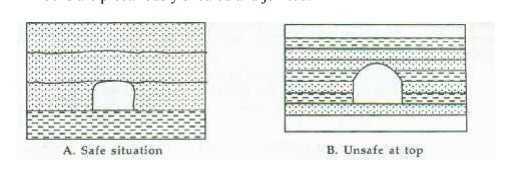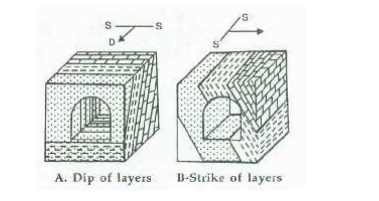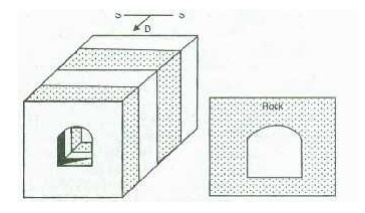Chapter: Civil : Engineering Geology : Application Of Geological Investigations
Geological Considerations In Tunnelling
GEOLOGICAL CONSIDERATIONS IN TUNNELLING
Rocks may be broadly divided into two categories
in relation to tunnelling: 1.consolidated and 2. unconsolidated or soft ground.
Only a brief accounts is given below.
(A) Consolidated Rocks
Tunnel design, method of its
excavation and stability are greatly influenced by following geological
conditions: lithology, geological structures and ground water conditions.
Lithology
It has already been mentioned
that information regarding mineralogical composition, textures and structures
of the rocks through which the proposed tunnel is to pass is of great
importance in deciding
the
method of tunneling
the strength and extent of lining and, thus the cost of the
project.
Hard and Crystalline Rocks
Ø These are
excavated by using conventional rock blasting methods and also by tunnel boring
method
Ø In the
blasting method, full face or a convenient section of the face is selected for
blasting up to a pre-selected depth
Ø These are
loaded with predetermined quantities of carefully selected explosives of known
strength.
Ø The
loaded or charged holes are ignited or triggered and the pre-estimated rocks
get loosened as a result of the blast.
Ø The
blasting round is followed by a mucking period during which the broken rock is
hauled out of the excavation so created.
Ø The
excavations in hard and crystalline rocks are very often self
supporting so that these could be left unlined and next round
of blasting in the new face created is undertaken, ensuring better advance
rate.
Ø Rocks
falling in this group include granites, diorites, syenites, gabbros, basalts
and all the related igneous rocks, sandstones, limestones, dolomites,
quartzites, arkose, greywackes and the like from sedimentary group and marbles,
gneisses, quartzites, phyllites and slates from the metamorphic groups.
Ø When any
one of these rocks is stressed, such as during folding or fractured as during
faulting, tunnelling in these rocks proves greatly hazardous.
Ø Rock
bursts which occur due to falling of big rock blocks from roofs or sides due to
release of stresses or falling of rock block along fractures already existing
in these rocks often cause many accidents.
Ø Soft
Rocks This group includes shales, friable and poorly compacted sandstones,
chalk and porous varieties of limestones and dolomities, slates
and phyllites with high degree of cleavage and also decomposed
varieties of igneous rocks.
Ø Their
excavation cost, volume for volume, might be lower than those in hard rocks.
Ø Hence,
temporary and permanent lining becomes necessary that would involve extra cost
and additional time.
Rocks
like clays, shales, argillaceous and ferruginous sandstones, gypsum bands and
cavernous limestones have to be viewed specially with great caution during
tunnelling
Ø Fissured Rocks form a category in
themselves and include any type of hard and soft rock that has been deformed
extensively due to secondary fracturing as a result of folding, faulting and
metamorphic changes of shearing type. (b)
Geological Structures Dip and
Strike
These two quantitative properties of rocks determine the
attitude (disposition in space) of the rocks and hence influence the design of
excavation (tunnel) to a great extent.
Three
general cases may be considered.
Horizontal
Strata
When encountered for small tunnels or for short lengths of
long tunnels, horizontally layered rocks might be considered quite favourable.
In massive rocks, that is, when individual layers are very
thick, and the tunnel diameter not very large, the situation is especially
favourable because the layers would then over bridge flat excavations by acting
as natural beams
But when The layers are thin or fractured, they cannot be
depended upon as beams; in such cases, either the roof has to be modified to an
arch type or has to be protected by giving a lining.
Sides of
tunnels, however, could be left unsupported except when the rocks are
precariously sheared and jointed.

Moderately Inclined Strata.
Such layers that are dipping at angles up to 45 o may be said
as moderately inclined.
The tunnel axis may be running parallel to the dip direction,
at right angles to the dip direction or inclined to both dip and strike
directions.
In the first situation, that is, when the tunnel axis is
parallel to the dip direction the layers offer a uniformly distributed load on
the excavation.
The arch action where the rocks at the roof act as natural
arch transferring the load on to sides comes into maximum play.
Even relatively weaker rocks might act as self-supporting in such cases. It is a favourable condition from this aspect.
it also implies that the axis of the tunnel has to pass through a number of rocks of the inclined sequence while going through parallel to dip

Ø In the
second case, that is, when the tunnel is driven parallel to strike of the beds
(which amounts to same thing as at right angles to the dip),
Ø the
pressure distributed to the exposed layers is unsymmetrical along the periphery
of the tunnel opening; one half would have bedding planes opening into the
tunnel and hence offer potential planes and conditions for sliding into the
opening.
Ø The
bridge action, though present in part, is weakened due to discontinuities at
the bedding planes running along the arch
Ø Such a
situation obviously requires assessment of forces liable to act on both the
sides and
along the roof and might necessitate remedial measures.
Ø In the
third case, when the tunnel axis is inclined to both the dip direction and the
strike direction, weak points of both the above situations would be
encountered.
Steeply
Inclined Strata
Ø In rock
formations dipping at angles above 45 o , quite complicated situations would
arise when the tunnel axis is parallel to dip or parallel to strike or inclined
to both dip and strike directions.
Ø In almost
vertical rocks for example, when the tunnel axis is parallel to dip direction,
the formations stand along the sides and on the roof of the tunnel as massive
girders.
Ø An
apparently favourable condition, of coarse, provided all the formations are
inherently sound and strong

Related Topics